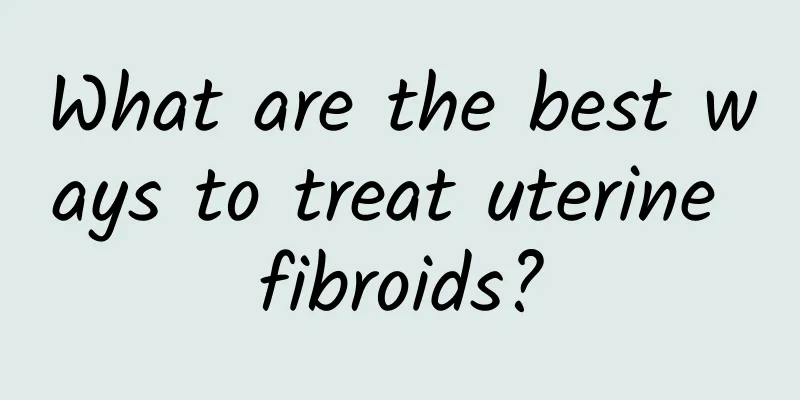Brief analysis of typical symptoms of uterine fibroids

|
Uterine fibroids are a very common uterine disease and the source of pain for many female friends. If uterine fibroids are not treated in time, they will cause other diseases. What are the common symptoms of uterine fibroids ? Here are some common symptoms of uterine fibroids. In general, common symptoms of uterine fibroids include: 1. Abdominal mass: Patients feel abdominal lumps themselves, mostly after uterine fibroids grow out of the pelvic cavity. It is often obvious in the early morning when the bladder is full on an empty stomach. It is one of the common symptoms of uterine fibroids. Because the uterus and fibroids are pushed upward, it is easy for patients to touch them themselves. If the uterus is larger than 4 to 5 months of pregnancy, it can also be touched when the bladder is not full. Uterine fibroids are generally located in the middle of the lower abdomen, and a few may be located on one side of the lower abdomen. They are hard or have an uneven feeling. Larger ones are more likely to be degenerated, softer and smoother. Most grow slowly. A very small number may grow faster or be accompanied by dull pain, and malignant changes should be suspected. 2. Pain: The symptoms of this type of uterine fibroids are that the tumor compresses the pelvic blood vessels, causing congestion, or compresses the nerves, or the pedicled submucosal fibroids can stimulate uterine contraction, which is discharged from the uterine cavity to the outside, causing the cervical canal to widen and cause pain; or the necrosis and infection of the fibroids cause pelvic inflammatory disease, adhesions, traction, etc. If some individuals have red degeneration of uterine fibroids, the abdominal pain is more severe and accompanied by fever. Acute and severe abdominal pain also occurs when the pedicle of the uterine subserosal fibroids is torsion or the axial torsion of the uterus. Large subserosal fibroids grow into the broad ligament, which can not only compress the nerves and blood vessels to cause pain, but also compress the ureters to cause ureteral or renal hydrops and cause low back pain. Those with severe and progressive dysmenorrhea are often caused by uterine fibroids complicated by adenomyosis or endometriosis. This is also a common symptom of uterine fibroids. 3. Uterine bleeding: Symptoms of this type of uterine fibroids occur in half or more of the patients. Most of them are excessive menstrual flow, prolonged menstruation or shortened menstrual cycle, accounting for about 2/3; persistent or irregular bleeding accounts for 1/3, which are also common symptoms of uterine fibroids. Bleeding is mainly caused by intramural fibroids and submucosal fibroids. Intramural fibroids often have periodic bleeding, while submucosal fibroids often show irregular bleeding. Subserosal fibroids rarely cause uterine bleeding, and in some cases, the menstrual flow is reduced. The above is an introduction to the common symptoms of uterine fibroids. I hope it will be helpful to everyone. Once the symptoms of uterine fibroids appear, you must go to the hospital for treatment immediately to avoid delaying the disease. |
<<: Experts explain how to properly arrange the diet for cervical erosion
>>: Understanding the cause of adnexitis can help you prevent this disease as much as possible.
Recommend
What are the symptoms of cervicitis
Cervicitis is one of the common gynecological dis...
Beware of the causes of chocolate cysts
We must understand the causes of chocolate cysts....
Children are prone to obesity, is it caused by excessive "dampness"? Chinese medicine practitioners recommend: Drinking Siwu Decoction and Kelp Soup to strengthen the spleen and remove dampness
Obesity can occur at any age, but is most common ...
What are the advantages of double-chamber decompression painless abortion
More and more women are having abortions. Do you ...
Can chronic dysmenorrhea be cured?
There are many diseases in life, and dysmenorrhea...
What are the types of female cervical erosion? Detailed description of the corresponding symptoms of different types of cervical erosion
In life, cervical erosion is a complex disease th...
What is Bartholinitis
What is Bartholin's glanditis? This is a rela...
What should you pay attention to after a painless abortion
Things to note for recovery and conditioning afte...
7 tips to get rid of abdominal fat during menopause without worries
Obesity can stimulate inflammatory substances in ...
What precautions should be taken before uterine fibroid surgery?
What precautions should be taken before uterine f...
How to self-check uterine fibroids
Uterine fibroids can cause a series of symptoms i...
Can you lose weight by eating only vegetables for dinner? Nutritionists teach you how to eat the right foods and lose weight without starving yourself
In order to lose weight successfully, many people...
Fat hands that refuse love! 7 Foods to Get Back Your Slim Waist
If a woman has extra fat around her waist, it is ...
What are the examination items for leucorrhea of vaginitis?
Leucorrhea is a mixture of vaginal mucosal exudat...
Aerobic exercise + unsweetened green tea reduces waist circumference by 2 inches
Some people can see results in just one month and...









